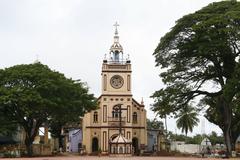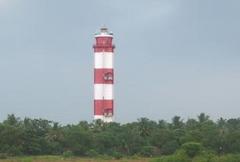
Fort Kochi Beach: Visiting Hours, Tickets, and Travel Guide to Ernakulam Historical Sites
Date: 03/07/2025
Introduction
Fort Kochi Beach, set against the Arabian Sea in Kerala, India, is a unique coastal destination where centuries of history, multicultural influences, and scenic beauty converge. Once a modest fishing village, Fort Kochi evolved into a vibrant heritage zone, renowned for its colonial architecture, bustling local markets, and iconic landmarks such as the Chinese fishing nets, St. Francis Church, and Mattancherry Palace. The beach and its environs serve as a living testament to Kerala’s legacy as a spice trade hub, attracting traders and colonizers from Portugal, the Netherlands, Britain, China, Arabia, and Jewish communities. Today, Fort Kochi Beach welcomes visitors to tranquil promenades, immersive heritage walks, and diverse cultural experiences, making it an essential stop for anyone exploring Kochi’s historical sites (keralascapes.com, Holidify, FortEKochi.in, TravelSetu).
Table of Contents
- Introduction
- Historical Overview
- Visiting Fort Kochi: Hours, Tickets & Practical Tips
- Must-See Attractions Near Fort Kochi Beach
- Local Cuisine and Dining Recommendations
- Unique Experiences and Cultural Events
- Visitor Challenges & Responsible Tourism
- Frequently Asked Questions (FAQ)
- Conclusion & Call to Action
- References
Historical Overview
Early Settlements and Strategic Importance
Fort Kochi’s prominence began with its strategic spot along key maritime routes on the Malabar Coast. Long before European colonization, it was frequented by traders from Arabia, China, and other parts of Asia, especially during the spice trade boom in the 14th century. The Chinese fishing nets, or “Cheena vala,” are enduring symbols of these early connections, introduced by Chinese traders and still used today (keralascapes.com, thelandofwanderlust.com).
Colonial Eras: Portuguese, Dutch, and British Influence
- Portuguese Era (1503–1663): The Portuguese were the first European colonizers, constructing Fort Immanuel and establishing St. Francis Church, the oldest European church in India and Vasco da Gama’s original burial site. Their influence is still visible in local architecture and street layouts (traveltriangle.com, tripoto.com, laurewanders.com).
- Dutch Period (1663–late 18th century): The Dutch reinforced the fort, built the Dutch Palace (Mattancherry Palace), and introduced new infrastructure. The Dutch Cemetery is a notable remnant from this period (keralascapes.com).
- British Era (late 18th century–1947): Under British rule, Fort Kochi saw the establishment of Santa Cruz Cathedral Basilica and further urban development, leaving a mark on the administrative and educational landscape (thrillophilia.com).
Visiting Fort Kochi: Hours, Tickets & Practical Tips
Visiting Hours
- Fort Kochi Beach: Open daily from about 6:00 AM to 7:00 PM. The beach is most vibrant at sunset.
- Historical Sites: Most, including St. Francis Church and Dutch Palace, are open 9:00 AM–5:00 PM. Confirm timings before visiting, especially on holidays.
Tickets
- Beach Access: Free for all visitors.
- Entry Fees: Some attractions—like Mattancherry Palace—charge nominal fees (typically INR 15–30). Purchase tickets at site entrances or online for certain museums and guided tours.
Accessibility and Transportation
- Getting There: Reachable by taxi, auto-rickshaw, local bus, or ferry from Ernakulam or Kochi city center.
- Mobility: Terrain is mostly flat; some heritage sites may have limited wheelchair access.
- Best Time to Visit: October to March offers the most pleasant weather.
Practical Tips
- Wear comfortable footwear for walking uneven lanes.
- Carry water, sun protection, and a camera for the best experience.
- Dress modestly, especially when visiting religious sites.
Must-See Attractions Near Fort Kochi Beach
- Chinese Fishing Nets: Iconic, photogenic nets operated by local fishermen, best viewed at sunrise/sunset (FortEKochi.in).
- St. Francis Church: The oldest European church in India and Vasco da Gama’s first resting place (Holidify).
- Santa Cruz Cathedral Basilica: A grand church noted for its Indo-European architecture.
- Mattancherry Palace (Dutch Palace): Museum of Kerala murals and royal artifacts.
- Jew Town & Paradesi Synagogue: Explore Kochi’s Jewish heritage and spice markets.
- Princess Street: Colonial-era street with cafes, art galleries, and boutiques.
- Kerala Kathakali Centre & Greenix Village: Daily performances of traditional dance and music.
- Vasco da Gama Square: Lively waterfront promenade with food stalls and souvenir vendors.
- Kashi Art Café: Café and art gallery popular for creative cuisine and local artwork.
- Ferry Rides & Backwaters: Take a boat to Vypin or Bolgatty Islands for scenic backwater views (FortEKochi.in).
Local Cuisine and Dining Recommendations
Fort Kochi’s culinary scene is a flavorful blend of Kerala traditions and colonial influences. Seafood is a highlight, with many restaurants and street vendors offering:
- Karimeen Pollichathu: Pearl spot fish cooked in banana leaf.
- Prawn Moilee: Prawns in coconut milk curry.
- Thali Meals: Traditional platters with rice, curries, and accompaniments.
- Fusion Bay, Kashi Art Café, Fort House Restaurant, Dal Roti, Brindhavan Vegetarian Restaurant, and Maple Sea Foods are highly recommended for diverse dining options.
Unique Experiences and Cultural Events
- Chinese Fishing Nets: Participate with local fishermen for a small fee.
- Heritage Walks: Guided tours through colonial streets and historic landmarks.
- Art & Cultural Festivals: The Kochi-Muziris Biennale and Cochin Carnival transform the area with installations, parades, and performances (TravelSetu).
- Street Food & Souvenirs: Sample Kerala snacks and shop for handicrafts at Vasco da Gama Square.
Visitor Challenges & Responsible Tourism
- Weather: Monsoon (June–September) brings heavy rain—plan accordingly.
- Waste Management: Help keep the beach clean; dispose of trash properly (Secret Attractions).
- Crowds: Visit early mornings or weekdays to avoid congestion during festivals/holidays.
- Swimming: Not recommended due to currents and fishing nets—visit Cherai Beach for safer swimming.
- Vendor Interactions: Bargain respectfully; carry small cash denominations.
Support local artisans and eco-friendly vendors to contribute to sustainable tourism.
Frequently Asked Questions (FAQ)
Q: What are the visiting hours of Fort Kochi Beach?
A: Generally open from 6:00 AM to 7:00 PM daily.
Q: Is there an entry fee or ticket required for the beach?
A: No, the beach is free. Some attractions nearby have nominal entry fees.
Q: Are guided tours available?
A: Yes, local operators offer heritage walks and guided tours covering key sites.
Q: Can I swim at Fort Kochi Beach?
A: Swimming is not recommended due to currents and fishing nets.
Q: How do I reach Fort Kochi Beach?
A: Take a taxi, auto-rickshaw, bus, or ferry from Kochi city or Ernakulam.
Conclusion & Call to Action
Fort Kochi Beach is a captivating blend of scenic beauty, layered history, rich cuisine, and lively culture. Plan your visit by considering the recommended hours, ticket details for heritage sites, and the best times for festivals and events. Explore on foot, participate in local traditions, and savor the diverse culinary offerings. For the latest travel tips, interactive maps, and exclusive guides, download the Audiala app and follow us on social media.
References
- Exploring Fort Kochi: History, Visiting Hours, Tickets & Must-See Kochi Historical Sites
- Fort Kochi Beach: Visiting Hours, Tickets, and Must-See Historical Sites in Kochi
- Fort Kochi Beach: Visiting Hours, Tickets, and Unique Experiences at Kochi’s Historical Coastal Gem
- FortEKochi.in – 15 Things to Do in Beautiful Fort Kochi
- TravelSetu – Fort Kochi Tourism Guide
- Times of India – Fort Kochi and Its Wonderful Treasures
- TravelTriangle – Beaches in Kochi
- Laure Wanders – Things to Do in Fort Kochi





